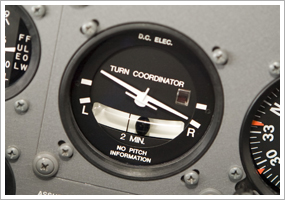| The following stories from the June 12, 2009, edition of AOPA ePilot were provided to AOPA members who expressed an interest in the particular subject areas. Any AOPA member can receive information tailored to their areas of interest by updating their preferences online. TRAINING TIPs‘Step on the ball’
That’s why advice to “step on the ball” is commonly offered to student pilots practicing maneuvers in training. But there’s a better instrument for performing the inclinometer’s function: you, the pilot. If you learned the finer points of using rudder to eliminate adverse yaw while practicing coordination exercises, slow flight, and stall recoveries, you have acquired the knack of sensing slip or skid as an uncomfortable sideward force acting upon your body. This is the “feel” that experienced pilots possess. They don’t need a ball to alert them to uncoordinated flight—and that includes your designated examiner!
The inclinometer can serve other uses, such as diagnosing an out-of-trim aircraft. Mark Twombly explained how in the November 1999 AOPA Flight Training’s “ Flying Smart: What it looks like.” “Suppose you are in straight-and-level cruise at a steady airspeed and you've adjusted the pitch trim to maintain that airspeed and attitude. If you have to maintain some pressure on one of the rudder pedals to keep the wings level and the ball centered in the inclinometer, it's a good bet that the airplane's rudder is out of trim,” he wrote.
Inclinometers have been around for a long time, but not all airplanes have them. If you learn to fly in a technically advanced aircraft, you may notice the absence of an inclinometer, one of many innovations described in the April 2007 AOPA Flight Training feature “ Glass Class: Meet your TAA.” So, whatever you fly, hone the ability to feel the difference between an aircraft in coordinated flight and one that is slip-sliding through the sky. TRAINING PRODUCTSCup Holder Organizer from Sporty’sCockpit organization is a never-ending battle, it seems, judging from the continual procession of products designed to keep your airborne office neat and tidy. The latest is the Cup Holder Organizer from Sporty’s Pilot Shop. The urethane foam container slips into a cup holder. It has three molded sections that can keep a cell phone, sunglasses, iPod, pens and pencils, and other small items in place. You get a set of two for $14.95. See the Web site or call 800/SPORTYS. |
 It’s the most unassuming instrument on the panel, so diminutive that it resides within the case of another instrument. Consisting of a ball inside a liquid-filled tube, the inclinometer—located beneath the miniature airplane in a turn coordinator, or beneath the needle of a turn-and-bank indicator—shows whether an aircraft is slipping or skidding through a maneuver. “If aileron and rudder are coordinated during a turn, the ball remains centered in the tube. If aerodynamic forces are unbalanced, the ball moves away from the center of the tube,” explains the discussion of inclinometers in Chapter 6 of the
It’s the most unassuming instrument on the panel, so diminutive that it resides within the case of another instrument. Consisting of a ball inside a liquid-filled tube, the inclinometer—located beneath the miniature airplane in a turn coordinator, or beneath the needle of a turn-and-bank indicator—shows whether an aircraft is slipping or skidding through a maneuver. “If aileron and rudder are coordinated during a turn, the ball remains centered in the tube. If aerodynamic forces are unbalanced, the ball moves away from the center of the tube,” explains the discussion of inclinometers in Chapter 6 of the 
